
The third-largest of North America’s Great Lakes, Lake Michigan boasts a surface area of about 22,400 square miles (58,000 km2). This massive freshwater body is an ecological treasure, providing a wealth of resources to its bordering states. Of course, its natural benefits extend throughout the whole continent as its network of lakes and tributaries support the needs and migration requirements of thousands of florae and fauna.
Large sections of Lake Michigan’s shoreline are designated as natural parks. They are associated with terrestrial wildlife refuges and forests. These protected areas support neighboring industries as well as the livelihood of millions of citizens that rely on their resources for survival. They are rich in natural vegetation and have stands extending from within the sunlit zones of the lake and further inland through emergent marshes and wet meadows.
A unique combination of endemic and non-native species makes up the aquatic and semi-aquatic plant communities of Lake Michigan. These can be classified into submerged plants, rooted floating-leaved plants, free-floating plants, emergent plants, and border plants (which include a number of terrestrial species with a tolerance for wet conditions). Some of the most common and noteworthy species are listed below.
Lake Michigan Plants
1) Floating-leaf pondweed (Potamogeton natans)
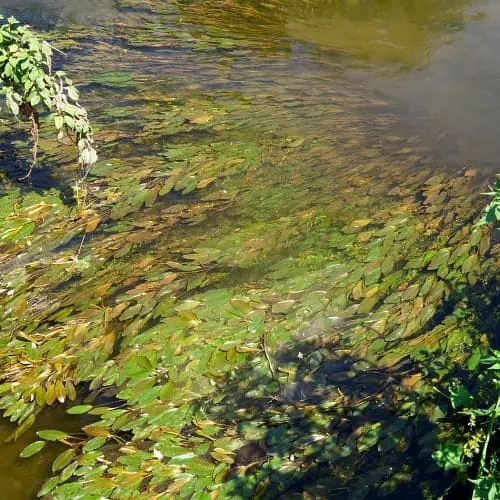
The floating-leaf pondweed thrives in Lake Michigan’s calmer sections, where waters are relatively quiet and slow-moving. In these zones, it persists as a partly submerged plant. Its roots are anchored to bottom substrates with depths of up to 20 feet. Arising from the roots are stems that grow towards the surface. These produce both submerged and floating leaves.
This aquatic plant is ecologically important because it is a viable source of nutrients for ducks, geese, moose, muskrats, deer, and beavers. All parts of the plant are safe to consume. Colonies of this type of pondweed are favored by many small fish, which may likewise forage on the leaves and stems. The shade provided by the floating leaves helps provide protection to many aquatic animals.
2) Clasping-leaf pondweed (Potamogeton perfoliatus)
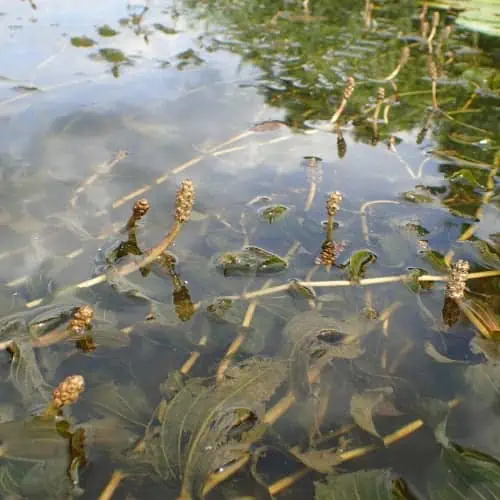
The clasping-leaf pondweed is a perennial aquatic that favors both standing water and freshwater systems with a mild current. Its healthiest and most robust specimens tend to be found in waters with a depth of at least 3.3 feet (1 meter). Compared to other pondweeds, particularly species with broadened and flat leaves, it is more likely to tolerate running water.
This particular pondweed is quite attractive as a pond plant. Anchored to the substrate by creeping rhizomes, the shoots produce oval-shaped leaves. As implied by the species’ common name, the base of its leaves appear to “clasp” the stems as they do not have petioles or stalks. Unlike other pondweeds, this species does not produce a separate type of floating leaf.
3) Water stargrass (Heteranthera dubia)
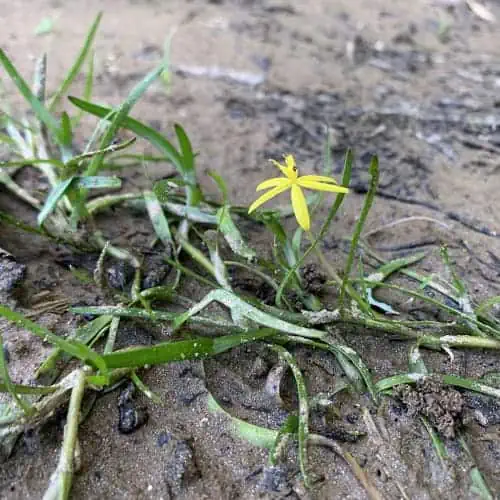
Water stargrass favors calm, shallow waters where its delicate shoots can remain submerged and largely undisturbed. It produces fine, grass-like leaves, each measuring up to 6 inches (15 cm) long, along the length of its stems. Upon close inspection, you’ll find that its narrow leaves are marked by veins. In some cases, particularly after periods of rainfall, this species can be found in depths of up to 16 feet (5 meters). It may also be found on the shoreline.
Stargrass specimens that are found in submerged vs exposed conditions have slightly different morphologies. Water flow can also alter leaf size and shape. In optimal environments, this plant may produce solitary, short-lived summer blooms. Graced with yellow petals, these look like tiny stars.
4) Wild celery (Vallisneria americana)
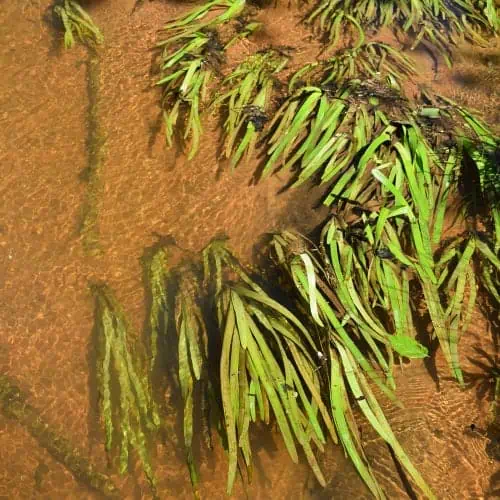
Also known as eelgrass or tape grass, wild celery is a remarkably valuable aquatic plant wherever it is found. It literally looks like an underwater type of grass, with leaves that are limp enough to simply flow in the direction of the current. Anchored to substrates by deep roots, it can tolerate a wide range of ambient conditions. As it can persist in water salinities of up 18 ppm, it is often found in estuaries and coastal areas.
Dense clumps of wild celery provide refuge and food for many animals in Lake Michigan. The canvasback (Aythya valisineria), for example, is a diving duck that may regularly feed on all parts of this species. Apart from serving as food and shelter, wild celery sequesters excess nutrients, serving as a natural filter in flowing waters.
5) Coontail (Ceratophyllum demersum)
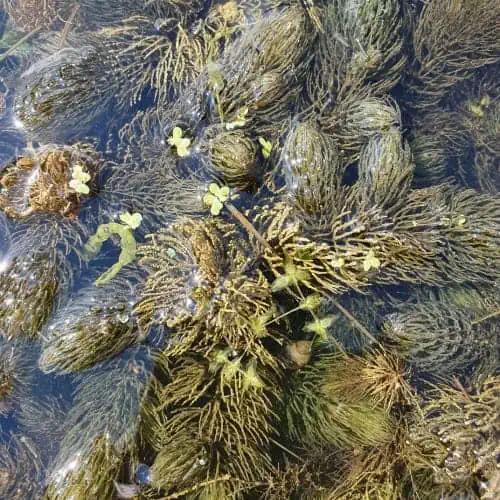
Often grown in tanks and ornamental ponds, the coontail is one of the most popular aquatic plants in the U.S. Its shoots quite literally look like bushy tails. Upon close inspection, you’ll find that they are covered in evenly spaced whorls of feathery leaflets. When grown close to one another, coontails can take on the appearance of a large and highly textural bush.
Coontail favors calm freshwater environments with mild to warm temperatures. Still waters allow it to grow to impressive lengths. Occasionally, a single shoot can measure as much as 10 feet (3 meters) tall. Though these are rooted into bottom substrates, they may also persist as free-floating stem fragments. Once fragments come into contact with a porous substrate, they can develop roots. For this reason, this species has the tendency to become invasive.
6) Bladderwort (Utricularia spp.)

Bladderworts are packed with interesting adaptations for survival in either terrestrial or aquatic locations. These highly specialized plants are actually carnivorous. They have impressively sophisticated bladder traps arising from their submerged stolons. These traps are basically miniature vacuums with flaps that can open and close to seal prey.
As tiny aquatic animals, such as Daphnia, swim around bladderworts, they may touch its bristles and trigger the opening of their traps. As the traps open to take in surrounding fluids, the tiny animals are captured as well.
7) Common duckweed (Lemna minor)

Common duckweed is a floating, freshwater plant with tiny, light green, and oval-shaped leaves. A single handful of this plant could contain tens of thousands of its minuscule leaves as they measure just 1 – 8 mm (0.04 – 0.3 in) long. Within the leaves are tiny pockets of air to help them remain afloat in still or lightly flowing waters. Able to rapidly form extensive colonies, this aquatic species is known for forming thick carpets on the water’s surface.
Due to its capacity for spread, common duckweed has the potential to be invasive. In quiet waters, it can completely cover the surface, blocking out light and oxygen. Its colonies can prevent the growth of other plants, especially those that must be rooted into bottom substrates. It can also deprive aquatic wildlife of oxygen. Cultivation should only be done in areas where its mats can be managed.
8) Cattails (Typha spp.)

Two notable types of cattails flourish within the vicinity of Lake Michigan and its neighboring lakes. These include the broadleaf cattail (T. latifolia), which is native to the area, and the narrowleaf cattail (T. angustifolia), which is a non-native species. Both of these species are known for hybridizing with one another to produce an even more aggressive crossbreed.
Both the narrowleaf cattail and its hybrid compete with broadleaf cattail, threatening its survival within the Great Lakes regions. The latter is a vital food source for many endemic birds, mammals, and insects, so the loss of its stands can ripple upward to disrupt the food chain. Locals are urged to avoid being vectors of the invasive narrowleaf cattail by ensuring they don’t transport its seeds via their boats, equipment, or shoes.
9) Pickerelweed (Pontederia cordata)

Pickerelweed favors the moist conditions of wetlands and lake systems throughout its native range. Its stands can even become well-established along rivers and swampy regions, like the Everglades. As an emergent plant, it thrives best when its crown is submerged in rich waters. It can tolerate periodic floods, making it useful along shorelines experiencing frequent fluctuations in water levels.
A recipient of the RHS Award of Garden Merit, this flowering herb has fantastic ornamental properties. Its upright stems grow to a maximum height of about 4 feet (1.2 meters). These produce clumps of shiny, bright green foliage that can measure as much as 10 inches (25 cm) long. Summer to fall blooms contrast the green leaves as they tower above them. They occur as bluish-purple inflorescences that can remain in bloom for several days.
10) Spatterdock (Nuphar lutea)

The humble spatterdock has medicinal, nutritional, and ornamental value throughout its extensive range. It is able to occupy both stagnant and moving bodies of freshwater, including those located at altitudes of up to 10,000 feet (3,000 meters). Its colonies favor shallow depths, though some well-established specimens have survived in depths of up to 16 feet (5 meters).
Like waterlilies, with which it shares many of its most obvious features, the spatterdock is rooted into bottom substrates. It spreads via networks of valuable rhizomes, which make for fantastic beaver and muskrat treats. Its stems make their way to the water’s surface, where they can bear their large floating leaves. In mid-spring to fall, mature plants produce sets of yellow flowers on emergent floral stalks. These attract a diversity of pollinators.
11) Curly-leaf pondweed (Potamogeton crispus)

The curly-leaf pondweed is a non-native plant that has developed extensive colonies in many of North America’s important freshwater systems. It is set apart from other pondweeds by its alternately arranged, linear leaves. These leaves have wavy margins, giving them a highly textural and multi-dimensional appearance. From May to October, this species produces emergent spikes of tiny flowers.
This perennial has a predominantly submerged habit. Its leaves may only appear to float on the surface when water levels have dropped to shallow depths. Its spreading rhizomes favor fine substrates in slow-moving, calcium-rich waters. As it is tolerant of pollutants, it may become crowded in ponds and lakes where other aquatic flora struggle to survive.
12) American white waterlily (Nymphaea odorata)

The American white waterlily is a highly-prized native plant because it has medicinal, nutritional, and ornamental benefits. It also contributes to a well-balanced ecology as it creates microhabitats where many small fish and aquatic insects can seek food and protection. Set apart by its large leaves and its fragrant spring-summer blooms, it is now a frequent favorite in aquatic gardens all across the globe.
This aquatic perennial is a rooted floating-leaved plant. It self-propagates by spreading via submerged rhizomes, anchored to the substrate by adventitious roots. It has no true stems as its leaves are simply anchored to the root system by their lengthy petioles. Depending on the subspecies (e.g. tuberosa or odorata), the petioles may be solid-colored or have dark purple stripes.
13) Purple loosestrife (Lythrum salicaria)

The purple loosestrife favors damp areas with poorly draining substrates. It thrives along the borders of freshwater features like lakes and ponds. Its stands can also be found in ditches, marshes, and meadows. Often perceived as a “wetland invader” outside of its native range, it can spread at a rapid pace and readily compete with less aggressive, native plants for space and nutrients.
Extensive stands of this non-native species can alter landscapes by trapping loose sediments. This can lead to a rising water table, altering the flow of stormwater. This may have a negative effect on an area’s natural ecology. ‘Beautiful but dangerous’ is undoubtedly an apt phrase for describing this flowering perennial.
14) Giant reed (Phragmites australis)

Another problematic plant with extensive stands around parts of Lake Michigan, the common or giant reed is an aggressive wetland grass. Its reed beds quickly transform damp areas and, when well-established, can easily tolerate periodic floods or significant increases in water level. Able to self-propagate via a network of horizontal runners, a single plant can spread by as much as 16 feet (5 meters) within a single year!
The upright stems of the giant reed grow to a full height of about 6 – 12 feet (1.8 – 3.7 meters). In summer, they produce dense inflorescences of purple flowers. These develop into seeds that are easily dispersed by both mechanical and live vectors. Young plants can quickly displace native plants and crowd out wetlands, making these habitats inhospitable to endemic fauna.
15) Dark-green bulrush (Scirpus atrovirens)

The dark-green or common bulrush is a type of sedge that naturally grows around degraded wetland habitats and freshwater systems. This perennial prefers full sun exposure, so its most widespread stands are found in openings along shorelines, exposed parts of swamps, and brightly lit ditches. Its stems (culms) bear broad yet linear leaves with textured margins. The grass-like foliage may be yellowish-green or deep green.
This marginal perennial produces terminal inflorescences each spring. Its spikelets of blooms are initially yellow-green. As the season progresses, they gradually become dark brown. Cross-pollination of the blooms is chiefly facilitated by wind action.
16) American arrowhead (Sagittaria latifolia)

Also known as duck-potato, katniss, or broadleaf arrowhead, this valuable perennial is often found along the margins of freshwater bodies and in shallow wetland systems throughout its native range. It is distinguished by its rosettes of arrow-shaped leaves, which are borne on lengthy, emergent petioles. The petioles can grow to impressive lengths (several meters long) in optimal environments.
American arrowhead colonies can become extensive enough to form widespread bands that follow the shoreline structure of ponds, lakes, and rivers. Their robust roots are able to firmly keep the plant anchored in areas with mild wave action or light currents. Their tubers were once a valuable form of food for many Native American tribes.
17) Hydrilla (Hydrilla verticillata)

Introduced into most regions of the West by the aquarium trade, hydrilla has become extensively naturalized in the US. This hardy aquatic plant can easily flourish in rich, freshwater systems with either cool or warm conditions. Fragments that escape cultivation can persist as floating plants prior to becoming rooted into substrates. Today, it is one of the problematic invasive weeds.
Rooted hydrilla specimens can grow toward the surface in sunlit waters with depths of up to 25 feet. Its abundant shoots can form mats that block out light and oxygen, depriving native aquatic plants of their basic survival needs. Unfortunately, despite its impacts in the US, it is still often sold as an aquarium or pond plant.
18) American waterweed (Elodea canadensis)

The American waterweed is a submerged aquatic plant with commercial value as a pond or tank perennial. Outside of its native range, it has proven to be an invasive species due to its rapid rate of spread and its capacity to persist and develop new roots as a floating fragment. Like hydrilla, its mature specimens are usually rooted onto bottom substrates, from which their stems elongate towards the water’s surface.
A single specimen of American waterweed can grow as long as 10 – 13 feet (3 – 4 meters). It may produce branches and adventitious roots throughout the length of its stems. In slow-moving waters with mild temperatures and ample sun exposure, this species can eventually choke out the water column. In its native range, its controlled stands do have ecological benefits as they may provide food and shelter for animals.
19) Watermilfoil (Myriophyllum spp.)

Watermilfoils are set apart by their whorls of feathery leaflets, which are often a favored food source in the wild. Waterfowl, for example, readily feed on the leaves and fruits of these submersed aquatic plants. Young fish, aquatic insects, and amphibians can also take shelter in their upright stands. Unfortunately, in the absence of grazers and competitive native plants, watermilfoils can prove to be problematic.
Three types of watermilfoils are perceived as potential pests throughout the Great Lakes region of the U.S. These include Eurasian watermilfoil (M. spicatum), parrot feather milfoil (M. aquaticum), and broadleaf watermilfoil (M. heterophyllum). Eurasian watermilfoil, a non-native species, is especially invasive and tends to require mechanical or chemical control.
20) Slender naiad (Najas flexilis)

The slender naiad or the nodding waternymph is a submerged annual plant. An important source of nutrients for fish, waterfowl, and muskrats, it possesses hairlike stems and equally narrow leaves. Hardy to USDA zones 4 – 8, this species favors shallow depths in either freshwater or brackish systems. Mature species produce flowers through summer, though these are generally inconspicuous. Dense stands of naiad shoots can provide cover for many juvenile aquatic animals.
21) Sago pondweed (Stuckenia pectinata)

Found in calm lakes, ponds, creeks, reservoirs, and canals, sago pondweed is a submerged aquatic perennial. It may also be referred to as fennel pondweed, sago false pondweed, or ribbon weed. This ecologically important species is anchored to bottom substrates by extensive root systems with starch-rich tubers. Diving waterfowl feed on the tubers and serve as vectors for the plant’s dispersal.
Shoots of sago pondweed are covered in branching stems with clumps of leaves. The leaves are lengthy, narrow, and tube-like. When they are suspended in water, they form fan-like or broom-like aggregations with tips that are oriented upwards. In spring to fall, submerged spikes of reddish purple blooms may appear.
22) Fern pondweed (Potamogeton robbinsii)

The fern pondweed is a colony-forming submerged plant that can grow in both deep and shallow waters. Its densest colonies tend to occur on muddy substrates along the bottoms of lakes or rivers. In optimal conditions, a single square meter of water may contain up to a thousand specimens of this species.
It may be challenging to correctly identify this species in the absence of its inflorescences. Its sterile and flowering stems have slightly different morphologies, with the latter having distinctly reduced leaves. The linear leaves are more crowded and lengthy on sterile stems. Among pondweeds of the Potamogeton genus, this species is the only one which produces branching inflorescences.
23) Common spike-rush (Eleocharis palustris)

Though spike-rushes look like grasses, they actually belong to a separate family of sedges (Cyperaceae). This flowering perennial forms monotypic stands along the margins of freshwater bodies. One of the most widespread members of its genus, Eleocharis, it spreads by sending out networks of creeping rhizomes. Specimens that are at least 2 – 3 years old are also able to self-seed.
Common spike-rush typically grows to a full height of about 3 – 5 feet (91 – 152 cm). The leaves on its culms function as sheaths, so it may look as though they are absent. Mature culms produce terminal inflorescences with tiny brown flowers. Once these are wind-pollinated, they develop into a large number of seeds. The viability of the seeds is usually poor, so colonies tend to be produced by vegetative growth.
24) Watermeal (Wolffia spp.)

Rivaling duckweed in terms of size and form, watermeal species are incredibly tiny. This group of aquatic floaters includes some of the smallest flowering plants in the world. Though they are members of the arum family (Araceae), which is known for its specialized inflorescences (spadix with an accompanying spathe), it’s quite rare to come across any of their flower structures.
Watermeal can be described as green specks on the water’s surface. They are only evident when they are found in mats with thousands of individual specimens. They often form colonies alongside similar plants, such as those of the Lemna genus. Though these plantlets can be microscopic in size, they are actually impressively high in protein. This goes to show that even the tiniest of greens can have a collective impact on the aquatic food chain.

